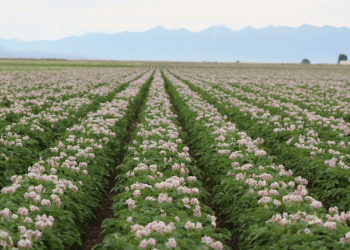Research scientist and part-time PhD student at the University of Groningen in the Netherlands Steven van der Wiek has developed a new innovative method for using an agricultural drone to measure, monitor and evaluate soil radioactivity levels directly from the air. This was reported on the portal futurefarming.com.
According to a study on “Radioelement Mapping from UAVs: Guidance and Verification Methods for Geophysical Field Inspection”, the UAV is equipped with a dedicated smart sensor to measure radioactivity in soil. Such an approach can be extremely useful for farmers, as the information obtained can not only help to assess the type of soil, control the content of minerals and nutrients in it, and inform about the current state, but also in the long term affect the health and fertility levels, in increasing crop yields in the future.
The information can be used by farmers and producers to optimize their fertilization processes or adapt irrigation and reclamation strategies. Until recently, such measurements could only be made from the ground using large and heavy detectors and analyzers. Now there is an efficient working method for accomplishing this task from the air with the help of UAVs. The technology has another indisputable advantage – the method is applicable in field areas that were previously inaccessible to the user from the ground.
Recall that almost all chemical elements known in nature, including radionuclides, are present in soils. The radioactivity of soils is due to the content of radionuclides in them. There are natural and artificial radioactivity. Soils have the highest natural degree of radioactivity among biospheric objects. The natural radioactivity of soils is caused by natural radioactive isotopes, which are always present in varying amounts in soils and soil-forming rocks.
Natural radionuclides are divided into 3 groups. The first group includes radioactive elements – elements, all of whose isotopes are radioactive: uranium (238U, 235U), thorium (232Th), radium (226Ra) and radon (222Rn, 220Rn). The second group includes isotopes of “ordinary” elements with radioactive properties: potassium (40K), rubidium (87Rb), calcium (48Ca), zirconium (96Zr) and others. The third group consists of radioactive isotopes formed in the atmosphere under the action of cosmic rays: tritium (3H), beryllium (7Be, 10Be) and carbon (14C). The gross content of natural radioactive isotopes mainly depends on parent rocks.
Soils formed on the weathering products of acidic rocks contain more radioactive isotopes than those formed on basic and ultrabasic rocks: heavy soils contain more of them than light ones. Natural radioactive elements are usually distributed relatively evenly over the soil profile, but in some cases they accumulate in illuvial and gley horizons.









